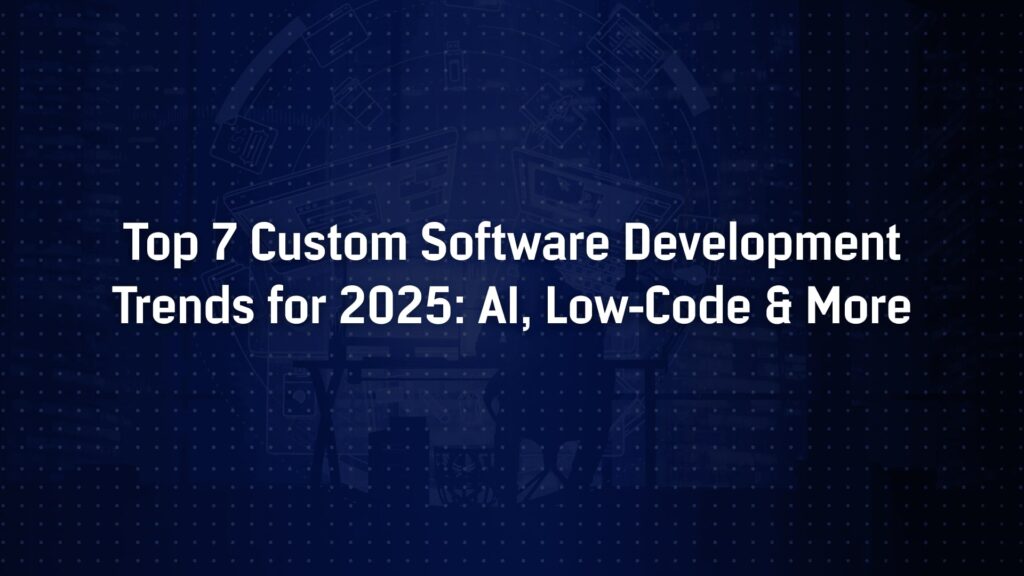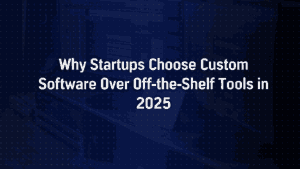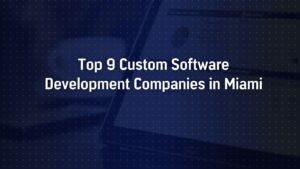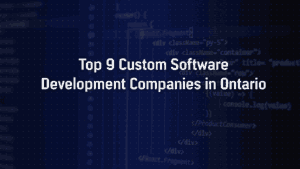Top 7 Custom Software Development Trends in 2025
The custom software landscape in 2025 is being shaped by rapid innovation, business demands, and emerging technologies. Companies can no longer rely on off-the-shelf solutions alone; they need bespoke systems that leverage the latest advances. Recent analyses emphasize that development in 2025 is “being redefined by artificial intelligence, developer automation, edge computing, and heightened concerns around security and compliance.” To stay ahead, teams must embrace new workflows and tools. This post explores the top 7 custom software development trends for 2025, including AI integration, low-code platforms, API-first design, and data privacy, along with market projections and client feedback. It also highlights how agile agencies like Empyreal Infotech are adapting to these trends to deliver future-ready solutions.
1. AI Integration and Machine Learning
Artificial Intelligence (AI) and machine learning are now integral to custom software. In 2025, AI-driven tools serve as full-fledged development partners. For example, code assistants like GitHub Copilot, Amazon CodeWhisperer, and open-source Large Language Model (LLM) based copilots have become “indispensable members of software teams,” automating boilerplate code generation, test creation, and code reviews. According to Datacenters.com, developers are shifting from manual coding to “curating pipelines” and “managing AI agents,” focusing on complex system design while AI handles routine tasks. This trend is backed by survey data: a Stack Overflow study found 63% of professional developers now use AI tools in their workflow (up from 44% the previous year). In other words, nearly two-thirds of developers are already writing code assisted by AI.
Key impacts of AI integration include:
-
- Faster coding and debugging: AI assistants autocomplete multi-line functions, suggest optimizations, and even fix bugs in real-time. For instance, AI tools can identify errors as you type and recommend fixes instantly.
-
- Automated testing: AI can generate unit and integration tests, reducing manual Quality Assurance (QA) effort. Datacenters.com notes that AI now generates entire test suites (including load tests) from code context.
-
- Natural language design: LLMs enable teams to describe desired features in plain English and get code or design prototypes in return. Product managers and UX designers can use AI tools to quickly generate interface code or documentation.
-
- Enhanced decision-making: AI-driven analytics and predictive models help developers optimize performance and resource use. For example, predictive maintenance algorithms can be embedded into software for IoT devices.
The productivity gains are dramatic. Morgan Stanley reports that early evidence suggests an individual developer’s output has already “risen by 10 times or more” with AI coding assistance. In other words, code that might have taken weeks to write can now be drafted in hours. However, the value shift is that developers now spend more time testing, interpreting, and integrating that code. As one expert observes, “writing code has become much faster with AI, but now the value is in testing it, understanding it, and seeing if it works for the business.”
AI is also becoming part of the embedded intelligence within custom applications. Trendy custom features include chatbots, recommendation engines, and intelligent data analytics built directly into enterprise software. Companies are launching internal AI platforms to deliver personalized user experiences and optimize processes. For example, agents and chat interfaces are being designed to analyze a company’s unique data, enabling context-aware assistance and automated business workflows.
Empyreal Infotech has actively embraced AI in its projects. Its clients note the team’s talent in integrating modern frameworks, one reviewer praised being “very hands-on with Flutter” and delivering tasks completely on time. By combining developer expertise with AI copilot technology, Empyreal Infotech can rapidly prototype features and iterate with clients. In practice, this means data-driven features (like Machine Learning-based recommendations) and AI-enhanced development flows (using LLMs for code generation) are well within Empyreal Infotech’s skill set.
2. Low-Code and No-Code Platforms
Low-code and no-code platforms continue democratizing software development. These tools allow even non-technical users to assemble applications from pre-built components via visual interfaces, drastically reducing the need for hand-coding. In 2025, this trend is accelerating: businesses can now launch Minimum Viable Products (MVPs) and internal apps in days, without lengthy development cycles. According to industry forecasts, the global low-code platform market was already valued at $26.3 billion in 2025, and it is projected to grow to $67.1 billion by 2030. This explosive growth is driven by pressures to modernize legacy systems and a shortage of skilled programmers.
Key aspects of the low-code trend:
-
- Faster Time-to-Market: With drag-and-drop tools and pre-built modules, companies prototype and deploy apps in weeks instead of months. This agility is crucial for businesses that need to pivot or update software quickly. For example, marketing teams can spin up customer-engagement portals or internal dashboards without waiting for a developer queue.
-
- Business Empowerment: Low-code enables “citizen developers.” Non-technical staff (e.g. in HR, marketing, operations) can build routine apps like approval forms or Customer Relationship Management (CRM) extensions themselves. This frees professional developers to focus on complex, custom logic. Tech commentators note that low-code lets businesses “empower business teams to solve real problems without writing code.”
-
- Cost Efficiency: By reducing the development effort on simpler features, low-code platforms lower project costs. Companies avoid hiring large development teams for basic applications. The Mordor Intelligence report highlights that government agencies and banks are actively procuring low-code solutions to meet strict deadlines, reflecting cost savings and speed.
-
- Limitations & Hybrid Approach: It is important to note that low-code is not a silver bullet. Complex enterprise systems still require custom development to ensure performance, scalability, and security. The common practice is combinatorial development: teams use low-code for front-end or administrative modules, while core business logic is hand-coded. Custom platforms often embed low-code modules into larger architectures.
The market data underscores the impact. Mordor Intelligence projects a 20.61% Compound Annual Growth Rate (CAGR) for low-code platforms from 2025 to 2030. Regulatory drivers (like new composable banking rules in the EU) and massive cloud adoption further fuel this trend. In essence, low-code is becoming a mainstream tool in the custom software arsenal.
Empyreal Infotech recognizes the role of low-code alongside traditional development. The company’s emphasis on “clean, scalable architecture” means it can integrate low-code solutions without sacrificing maintainability. For instance, Empyreal Infotech might use a platform like Mendix or OutSystems to rapidly deliver a proof-of-concept, then hand off to its developers for hardening. This hybrid approach keeps costs down and speeds delivery, while still meeting enterprise standards.
3. API-First and Composable Architecture
In 2025, APIs (Application Programming Interfaces) are treated not as afterthoughts but as first-class products. An API-first design approach underpins virtually all modern custom software. Instead of building a monolithic application, developers break functionality into modular services that communicate via well-defined APIs. This composable architecture allows businesses to mix and match components—internal or third-party—much like building blocks.
Key trends in API-driven development:
-
- API as Product: Teams invest in designing, documenting, and versioning APIs with the same care as user-facing features. For example, a retail company might expose product and inventory APIs that internal apps and partners can use. Treating APIs as products means adding monitoring, analytics, and monetization channels for them.
-
- Microservices & Event-Driven Systems: Custom software increasingly uses microservices and asynchronous messaging. A service-oriented backend might use REST or GraphQL APIs alongside event brokers (Kafka, Pulsar, etc.) to handle real-time data flows. This is critical for scalability: each microservice can be developed, deployed, and scaled independently.
-
- REST to GraphQL: Many teams migrate from traditional REST endpoints to GraphQL, which lets front-ends request exactly the data they need. This flexibility reduces over-fetching and under-fetching of data, improving performance for complex clients.
-
- Advanced API Gateways: Modern API gateways now incorporate rate-limiting, OAuth/JWT security, and usage tracking. These gateways ensure that even composed microservices adhere to enterprise security policies. Observability platforms can trace requests across services, vital in distributed architectures.
-
- Third-Party Integrations: Businesses partner through APIs. For example, a custom e-commerce platform might integrate multiple payment gateways, shipment tracking services, or CRM systems via APIs. An API-first mindset simplifies these integrations, since each external system is just another service to connect.
These practices are recognized industry-wide. A TechMave article lists “Composable & API-First Architecture” as a 2025 trend and advises adopting tools that speed API integration. Indeed, they note that companies can “scale modular software products faster and cheaper” by being composable.
Empyreal Infotech in API-first design: Empyreal Infotech’s projects often start with a clear API strategy. As one profile notes, the company emphasizes robust architecture and clean coding standards. In practice, this means when building a mobile app or web portal, Empyreal Infotech will first define the REST/GraphQL interfaces and data contracts. This API layer then allows front-end and back-end teams to work in parallel, or for clients to swap out front-ends (e.g. replacing a web app with a Progressive Web Application (PWA) or native app) without overhauling the backend. By leveraging API-first design, Empyreal Infotech ensures flexibility and future-proofing.
4. Data Privacy and Security (DevSecOps)
By 2025, data privacy and security will be non-negotiable priorities in custom software. Privacy laws have proliferated worldwide. For example, GDPR in Europe is now joined by dozens of state and national regulations. As of early 2025, Osano reports that over seven US states had enacted comprehensive privacy laws in 2023–24, and the number could reach 26 out of 50 states by 2025. This patchwork forces businesses to comply with a complex array of rules. Unlike the pre-2018 “Wild West” of data, companies must embed privacy-by-design into every project.
Key points on this trend:
-
- Security by Design (Shift-Left Security): Organizations now bake security into the software development lifecycle. Datacenters.com notes that the “Shift Left” movement has matured: static code scanning, secrets management, and threat modelling occur during coding, not just in QA. For example, Continuous Integration (CI) pipelines may include automated Static Application Security Testing (SAST) and third-party dependency checks.
-
- DevSecOps Culture: DevSecOps: teams empower developers with security tools directly in their IDEs and workflows. Practices include automated unit and integration security tests, container image scanning, and infrastructure-as-code security reviews. This continuous approach catches vulnerabilities early and reduces last-minute patch rushes.
-
- Zero Trust & Encryption: New applications often adopt zero-trust principles: no implicit trust, always verify. This can mean microservices enforce authentication/authorization at each hop, and all data is encrypted in transit and at rest. Compliance requirements (like HIPAA for healthcare, or SOC 2 for services) often demand such safeguards.
-
- Privacy Regulations: Custom software must support user data rights. That means implementing features like data access requests, data deletion, and consent management. For example, a CRM system may need an interface for exporting or anonymizing a user’s records. With more jurisdictions (and upcoming rules like California’s ADPPA or Europe’s AI Act), developers must be prepared to adapt their designs.
-
- AI Governance: As AI is integrated, regulatory focus is emerging. The EU AI Act and several US states are imposing rules on AI systems (e.g. bans on high-risk applications, documentation requirements). Custom AI modules must therefore include explainability and robust privacy controls when dealing with personal data.
Real-world projections emphasize the stakes: Datacenters.com warns that the “cost of non-compliance is rising” and security is now a baseline requirement. Every flaw or breach can lead to fines, lawsuits, and loss of customer trust. Therefore, custom projects in 2025 often have dedicated security experts on the team, or at least security champions.
Empyreal Infotech’s development process reflects this emphasis. Testimonials highlight their meticulousness: one client remarked that Mohit and his team “will do everything possible to make sure the job is done to satisfaction.” Implicitly, that includes attending to quality and security. Empyreal Infotech’s philosophy of clean architecture naturally supports security – modular, well-structured code is less prone to critical flaws. While no testimonial explicitly mentions security, clients do praise Empyreal Infotech’s professionalism and communication, which suggests they are proactive about raising and addressing security concerns during projects.
5. Cloud-Native Development and DevOps
Cloud computing is now the default environment for new applications. In 2025, custom software is almost universally built to be cloud-native: containerized, microservices-based, and infrastructure-as-code managed. This trend ensures that applications can scale elastically and be deployed rapidly around the globe.
Key elements include:
-
- Microservices & Containers: Applications are decomposed into small, independently deployable services (e.g. via Docker containers, Kubernetes). This allows teams to scale only the parts of the app that need it. As one trend report observes, “Modern dev practices now centre around microservices, Kubernetes, and serverless deployment. Cloud-native isn’t a choice – it’s the new normal.”
-
- Infrastructure as Code (IaC): DevOps teams use Terraform, CloudFormation, or similar tools to script their environments. Entire cloud stacks (networks, servers, databases) are version-controlled and repeatable. This reduces configuration drift and enables rapid disaster recovery.
-
- CI/CD Pipelines: Continuous Integration and Deployment (CI/CD) is a cornerstone. Automated pipelines build, test, and deploy code across staging and production with minimal manual intervention. This pipeline often includes security gates (as noted above) and automated testing to maintain quality at speed.
-
- Internal Developer Platforms (IDPs): For larger organizations, platform engineering has emerged. An internal developer platform provides self-service environments: developers can spin up QA or production instances with a few clicks. Datacenters.com describes these IDPs as “providing consistent environments for building, testing, and deploying applications,” abstracting away cloud complexity like Kubernetes details.
-
- Serverless & Edge Integration: While not replacing microservices entirely, serverless functions are increasingly used for certain tasks (e.g. image processing, background jobs). These can run in traditional clouds or on edge networks.
The WellDev report highlights that cloud-native approaches yield scalability, cost efficiency, and faster updates. Indeed, on-demand infrastructure means companies pay only for actual usage, a boon for budget-conscious projects. Scalability is critical in custom apps that may see sudden user surges (e.g. a retail promotion or global event).
Empyreal Infotech’s team is experienced with full-stack cloud development. Their portfolio mentions diverse industries (finance, healthcare, marketing) – many of which rely on robust cloud architectures. The agency’s emphasis on a “disciplined architecture” ensures cloud workloads are well-structured (e.g. stateless services, multi-region deployment for redundancy). Furthermore, Empyreal Infotech offers 24/7 support, which is often facilitated by cloud infrastructure monitoring and automated alerting. In short, Empyreal Infotech is equipped to build and maintain complex cloud-native solutions that reflect best DevOps practices.
6. Edge Computing, IoT, and Real-Time Data
The proliferation of connected devices and high-speed networks is moving computing closer to users and sensors. Edge computing, which processes data on local devices or nearby servers, is emerging as a key trend. Especially in latency-sensitive applications like Augmented Reality/Virtual Reality (AR/VR), autonomous vehicles, and smart factories, waiting for a round-trip to a distant cloud is too slow.
Important aspects:
-
- Low-Latency Applications: By running code on edge servers or even on-device, applications can respond instantly. Datacenters.com notes that “edge-native development” is practical in 2025, with specialized edge databases and frameworks becoming common. For example, a video analytics system can process camera feeds locally to detect hazards in real-time.
-
- IoT Expansion: The Internet of Things (IoT) continues to grow. 5G and Low-Power Wide-Area Network (LPWAN) networks now connect millions of sensors and smart devices. These generate torrents of data. Instead of sending everything to a central cloud, edge computing filters, aggregates, or analyzes data at the source. TechMave highlights that as “5G and IoT mature, edge computing is being used in everything from smart cities to healthcare,” which not only improves speed but also “increases data privacy” by keeping sensitive data local.
-
- Offline & Resilient Operation: For remote or unreliable connectivity situations (industrial sites, rural installations, or disaster scenarios), edge servers allow apps to function offline and sync later. Custom enterprise software is increasingly designed to handle intermittent connectivity gracefully.
-
- New Tooling: In 2025, developers have edge-optimized tools. Cloudflare Workers, AWS Greengrass, Azure IoT Edge, and similar platforms let teams deploy functions to the edge. Specialized edge databases (e.g. Redpanda, Macrometa) handle local data storage with sync capabilities.
-
- Use Cases: Logistics companies use edge devices to track shipments and adjust routes in real-time. Smart factories run predictive maintenance algorithms directly on machinery sensors to avoid breakdowns. Telemedicine apps process patient data on local devices to maintain privacy.
Empyreal Infotech’s experience covers many IoT and edge projects. The Empyreal Infotech portfolio includes solutions in logistics, manufacturing, and healthcare, where such real-time processing is crucial. The team’s strong communication and adaptability mean they can integrate edge components with central systems seamlessly. For instance, a custom dashboard might receive live IoT data via APIs (see Trend 3) and display insights, while also feeding data back for cloud analytics. By leveraging modern edge frameworks, Empyreal Infotech ensures clients’ custom systems can meet the demands of connected, on-the-move user experiences.
7. Unified Development Platforms and Collaboration Tools
Managing the complexity of modern development toolchains is a growing challenge. In 2025, many organizations will turn to unified platforms and advanced collaboration tools to streamline workflows. This trend overlaps with platform engineering but focuses on the developer experience.
Key elements:
-
- Unified Dev Environments: Tools like GitHub Codespaces, Gitpod, or custom IDPs provide cloud-based development environments. Developers can start coding in a pre-configured container instantly, without local setup hassles. This ensures consistency (everyone uses the same environment) and speeds up onboarding.
-
- All-in-One Platforms: Some companies adopt platforms that bundle issue tracking, version control, CI/CD, and monitoring in one interface. For example, GitLab and Azure DevOps offer integrated suites. A “unified development platform” centralizes these tools, reducing the friction of context switching.
-
- Real-Time Collaboration: Visual, multimodal tools (like Figma or even emerging AI-powered design-to-code tools) allow teams to co-author code and designs together. Developers, designers, and product managers can work in live shared coding sessions or visual code canvases. This trend democratizes development: stakeholders without deep coding skills can contribute directly to the product.
-
- Platform Engineering: As noted earlier, internal platforms automate routine operations. The IDP abstracts away repetitive tasks (like provisioning a Kubernetes namespace or database). Developers simply declare what they need, and the platform handles the rest. This saves time and reduces errors.
-
- Centralized Documentation & Knowledge: Modern tools often embed wiki or documentation features (e.g. JIRA with Confluence, or in-code documentation generators). Having one source of truth for architecture, APIs, and onboarding docs is now standard practice.
For large and distributed teams, these unified approaches “enhance productivity” by minimizing tool sprawl. WellDev notes that such platforms offer “centralized collaboration” with real-time updates and shared workspaces. Developers spend less time switching between chat apps, source control, and build servers. They can trigger deployments or run tests with one click.
Empyreal Infotech’s distributed team (with offices in India, the US, and the UK) benefits from these tools. The company’s agile workflows likely leverage cloud IDEs and shared issue trackers to coordinate across time zones. Clients praise Empyreal Infotech for “strong communication” and a collaborative spirit. This is enabled by modern collaboration platforms and clear project documentation. By using unified development environments, Empyreal Infotech’s engineers can collaborate more closely with client teams, even embedding stakeholders into daily standups via video and pair-programming tools. The result is smoother project execution and quicker problem-solving.
Empyreal Infotech’s Adaptability and Client Success
Across all these trends, Empyreal Infotech exemplifies an adaptable, forward-looking development partner. The agency prides itself on keeping pace with modern technology stacks while maintaining disciplined processes. For example, an industry profile highlights Empyreal Infotech’s emphasis on “clean, scalable architecture and robust coding standards,” which ensures that custom solutions remain maintainable over time. Coupled with “exceptional maintenance & support,” this gives Empyreal Infotech’s clients a competitive edge in a fast-moving landscape.
Empyreal Infotech’s track record spans industries like finance, healthcare, IT, and retail, indicating their versatility in applying new trends to different domains. They offer full-stack expertise in mobile and web apps, e-commerce, and CRM systems. Critically, clients regularly praise Empyreal Infotech’s service quality. For instance, a London-based client hailed the team’s approach as “second to none… Professional throughout and [always] on hand to answer any questions.” Another client from Sydney recommended Empyreal Infotech for their strong communication and professionalism. One Australian client emphasized that Mohit and his team “will do everything possible to make sure the job is done to satisfaction.” These testimonials reflect an agency that not only uses the latest tools, but also cares deeply about customer success.
Empyreal Infotech’s adaptability is evident in their tech choices. Their developers are proficient in modern frameworks (one testimonial specifically mentioned Flutter), and they build both cloud-native and on-premise solutions as needed. The combination of modern skillsets and a global, responsive team means they can adopt low-code solutions for quick wins, integrate AI modules for innovation, enforce strict security standards, and design API-driven architectures – essentially leveraging all the trends discussed.
Conclusion
Custom software development in 2025 is defined by intelligence, automation, and user-centred design. From AI integration and low-code platforms to API-first architectures and privacy-first security, successful projects will combine multiple emerging trends. The data is clear: AI-augmented development and cloud-native practices are already mainstream, while market forecasts show explosive growth for low-code and privacy tools.
To leverage these trends, businesses need partners who are both technically current and customer-focused. Empyreal Infotech is one such partner. With a proven track record of clean architecture, a global full-stack team, and enthusiastic client testimonials, Empyreal Infotech demonstrates the agile mindset needed for 2025 and beyond. Their ability to iterate quickly (using AI tools), integrate low-code modules, design robust APIs, and enforce security controls shows their alignment with the seven trends outlined above.
In summary, the top trends in custom software for 2025 are driving a shift towards smarter, more secure, and more modular development. Teams that actively adopt these trends and the right partners who can implement them will outpace the competition. Whether it is harnessing generative AI to accelerate development, embracing visual low-code tools, or designing with privacy by default, the future belongs to those who adapt.




